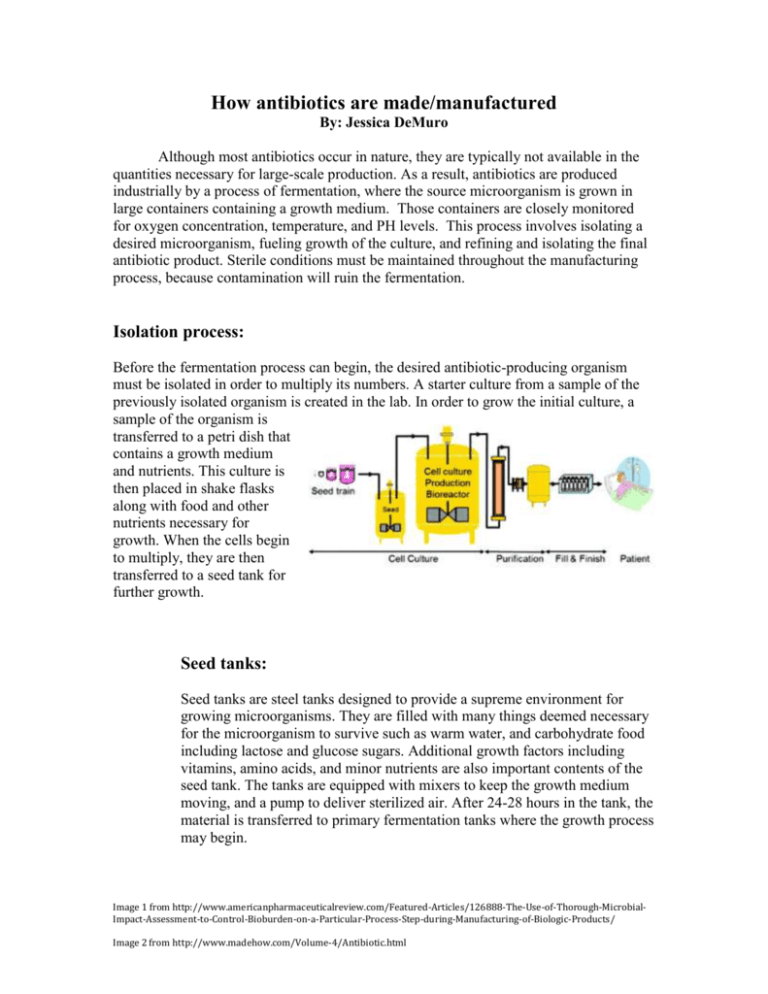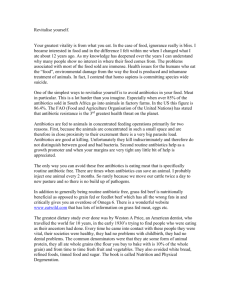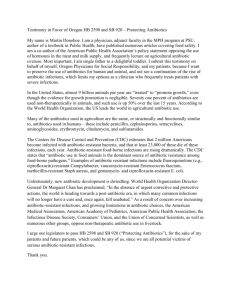How Antibiotics Are Made
advertisement

How antibiotics are made/manufactured By: Jessica DeMuro Although most antibiotics occur in nature, they are typically not available in the quantities necessary for large-scale production. As a result, antibiotics are produced industrially by a process of fermentation, where the source microorganism is grown in large containers containing a growth medium. Those containers are closely monitored for oxygen concentration, temperature, and PH levels. This process involves isolating a desired microorganism, fueling growth of the culture, and refining and isolating the final antibiotic product. Sterile conditions must be maintained throughout the manufacturing process, because contamination will ruin the fermentation. Isolation process: Before the fermentation process can begin, the desired antibiotic-producing organism must be isolated in order to multiply its numbers. A starter culture from a sample of the previously isolated organism is created in the lab. In order to grow the initial culture, a sample of the organism is transferred to a petri dish that contains a growth medium and nutrients. This culture is then placed in shake flasks along with food and other nutrients necessary for growth. When the cells begin to multiply, they are then transferred to a seed tank for further growth. Seed tanks: Seed tanks are steel tanks designed to provide a supreme environment for growing microorganisms. They are filled with many things deemed necessary for the microorganism to survive such as warm water, and carbohydrate food including lactose and glucose sugars. Additional growth factors including vitamins, amino acids, and minor nutrients are also important contents of the seed tank. The tanks are equipped with mixers to keep the growth medium moving, and a pump to deliver sterilized air. After 24-28 hours in the tank, the material is transferred to primary fermentation tanks where the growth process may begin. Image 1 from http://www.americanpharmaceuticalreview.com/Featured-Articles/126888-The-Use-of-Thorough-MicrobialImpact-Assessment-to-Control-Bioburden-on-a-Particular-Process-Step-during-Manufacturing-of-Biologic-Products/ Image 2 from http://www.madehow.com/Volume-4/Antibiotic.html Fermentation tanks: The fermentation tank is much larger than the seed tank with a holding capacity of approximately 30,000 gallons. The tank provides the same growth media found in the seed tank along with an environment that induces cell growth. This is where the microorganisms grow and multiply, excreting large quantities of the antibiotic. The temperature of the tanks is constantly monitored and kept between 78-81 degrees Fahrenheit. It is important to ensure a continuous supply of sterilized air is being pumped in to the tank to avoid contamination. Anti-foaming agents, and acids or bases are periodically added to promote optimal growth. Isolation: The maximum amount of antibiotic is produced after sitting in the fermentation tanks for a 3-5 day period, and the isolation process may now begin. The fermentation broth is processed by various purification methods depending on the specific antibiotic. Water-soluble antibiotic compounds: For antibiotics that are water soluble, an ion exchange method is used for purification. The compound is first separated from the waste organic materials found in the broth, and then sent through equipment. This equipment separates the other water-soluble compounds from the desired one. Oil soluble antibiotic compounds: To isolate an oil-soluble antibiotic such as penicillin, a solvent extraction method is used. This method uses organic solvents such as butyl acetate to specifically dissolve the antibiotic. The dissolved antibiotic is then recovered using various organic chemical means. The end result of this method is a purified powdered form of antibiotic, which is then further refined in to different product types. Image 1 from http://www.americanpharmaceuticalreview.com/Featured-Articles/126888-The-Use-of-Thorough-MicrobialImpact-Assessment-to-Control-Bioburden-on-a-Particular-Process-Step-during-Manufacturing-of-Biologic-Products/ Image 2 from http://www.madehow.com/Volume-4/Antibiotic.html Purification: Antibiotic products are available in several different forms. They can be sold in solutions for syringes, in pill or gel capsule form, or they may be sold as powders, which are used for topical ointments. Depending on the final form of the antibiotic, various steps must be taken after the initial isolation of the antibiotic to further enhance the final product. For gel capsules, the powdered antibiotic is physically filled into the bottom half of a capsule and the top half is mechanically put in place. For topical ointments, the antibiotic is physically mixed into the ointment. The final antibiotic product is now transported to the final packaging stations where it is stacked and put in boxes. The boxes are transported to various distributers, hospitals, and pharmacies. The entire manufacturing process of fermentation, recovery, and processing may take anywhere from five to eight days. Quality Assurance: Quality assurance is the most important thing to consider when producing antibiotics. Since the production of antibiotics involves a fermentation process, making sure there is no contamination introduced at any point in the process is a vital step. For this reason, frequent checks are made of the condition of the microorganism culture during the fermentation process. The equipment used to process antibiotics must be thoroughly steam sterilized before the process may begin. Various physical and chemical properties of the finished product are also checked including pH, melting point, and moisture content. Antibiotic production in the United States is highly regulated by the Food and Drug Administration (FDA). The FDA requires that for certain antibiotics each batch must be checked for effectiveness and purity before being sold for consumption. The Future of Antibiotic Growth: Antibiotics are not as effective at killing bacteria as when they were first introduced. It is estimated that 77,000 people die of infections caused by resistant bacteria in the United States every year. Due to their quick generation times and high numbers, bacteria have a high capability to quickly adapt to changing environments. Scientists are suggesting that this evolution of resistance to antibiotics is a result of the overuse and misuse of antibiotics. As a result, scientists are recommending that the agricultural industry discontinue the use of antibiotics on crops and livestock. Doctors must also refrain from prescribing broad-spectrum antibiotics, which kill many different types of bacteria, and must begin to focus on prescribing an antibiotic to specifically target the bacteria causing the infection. Most “new” antibiotics manufactured today are modified from the older ones, but often so similar to older versions that resistance is still evolving very quickly. Although research on the optimal use of antibiotics is still under way today, it is still unclear how exactly to decrease the rate of resistance to these “miracle” drugs. Image 1 from http://www.americanpharmaceuticalreview.com/Featured-Articles/126888-The-Use-of-Thorough-MicrobialImpact-Assessment-to-Control-Bioburden-on-a-Particular-Process-Step-during-Manufacturing-of-Biologic-Products/ Image 2 from http://www.madehow.com/Volume-4/Antibiotic.html






